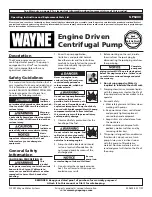
Page 9 / 48
NR, NR4 Rev. 13 - Operating Instructions
GB
Signal individual protection device
HAND PROTECTION
(gloves for protection against chemical, thermal
and mechanical risks).
EYE PROTECTION
(glasses for protection from chemical, thermal
and biological risks).
5. TRANSPORTATION AND HANDLING
The product is packed to maintain the content intact.
During transportation avoid to stack excessive weights.
Ensure that during the transportation the packed cannot move.
The transport vehicles must comply, for the weight and
dimensions, with the chosen product (see paragraph
12.1 dimensions and weights).
5.1 Handling
Handle with care, the packages must not receive
impacts.
Avoid to impact onto the package materials that could
damage the pump.
If the weight exceeds 25 Kg the package must be hand-
led by two person at the same time (see paragraph 12.1
dimensions and weights).
Raise the pump-motor unit slowly (fig.1), making sure it
does not move from side to side in an uncontrolled way,
to avoid the risk of imbalance and tipping up.
6 INSTALLATION
6.1 Dimensions
For the dimensions of the device refer to the annex
"Dimensions" (paragraph 12.1 Annexes).
6.2 Ambient requirements and installation site
dimensions
The customer has to prepare the installation site in order
to guarantee the right installation and in order to fulfill the
device requirements (electrical supply, etc...).
The place where the device will be installed must fulfill the
requirements in the paragraph 3.2.
It's Absolutely forbidden to install the machine in an
environment with potentially explosive atmosphere.
6.3 Unpacking
Inspect the device in order to check any damages
which may have occurred during transportation.
Package material, once removed, must be discarded/recy-
cled according to local laws of the destination country.
Raise the pump-motor unit slowly (see paragraph 12.2
fig.1), making sure it does not move from side to side in
an uncontrolled way, to avoid the risk of imbalance and
tipping up.
6.4. Installation
The
NR, NR4
(
NRM, NR4M
with single phase motor)
close coupled pumps have suction and delivery connec-
tions with the same diameter and on the same axis (in-
line), so that thet may be inserted into a straight pipe like
a gate valve.
Into stable and rigid pipelines the pump can be suppor-
ted directly through the flanges (fig. 2).
If the pipe is not stable enough, the pump must be faste-
ned and supported by the suitable threaded holes on the
pump casing (fig. 3).
The
NR, NR4
in-line pumps can be flanged in the pipe at
any angle.
For safety reasons avoid the position with the motor
under the pump.
For installation in a position other than with a vertical
rotor axis, care must be taken to see that a
drain and
condensation water hole
is provided at the lowest point
of the motor.
Provide enough clearance around the unit for
motor
ventilation,
for inspections, to check the rotation of the
shaft and for filling and draining the pump.
6.4.1. Pipes
Ensure the insides of pipes are clean and unobstructed
before connection.
ATTENTION: The pipes connected to the pump
should be secured to rest clamps so that they do not
transmit stress, strain or vibrations to the pump.
The inside diameter of the pipe-work depends on the
desired flow.
Provide a diameter assuring a liquid flow not greater than
1.5 m/s for suction and 3 m/s for delivery.
The pipe diameters must never be smaller than the pump
connection ports.
6.4.2. Suction pipe
The suction pipe must be perfectly airtight and be led
upwards in order to avoid air pockets.
With a
pump located above the water level
(suction lift
operation), fit a
foot valve
or a
check valve
on the suc-
tion connection.
With
a pump located below water level
(inflow under
positive suction head) install a gate valve.
6.4.3. Delivery pipe
Fit a gate valve in the delivery pipe to adjust delivery,
head, and absorbed power.
Install a pressure gauge.
With a geodetic head of over 15 m fit a check valve
between the pump and the gate valve in order to protect
the pump from water hammering.
6.5 Electrical connection
Electrical connection must be carried out only by
a qualified electrician in accordance with local
regulations.
Follow all safety standards.
i
OFF
(fig. 1)
4.93.032.2
(fig. 3)
(fig. 2)
IST NR_ED13_2017_MXS 11_03con gall 17/10/17 08:58 Pagina 9










































